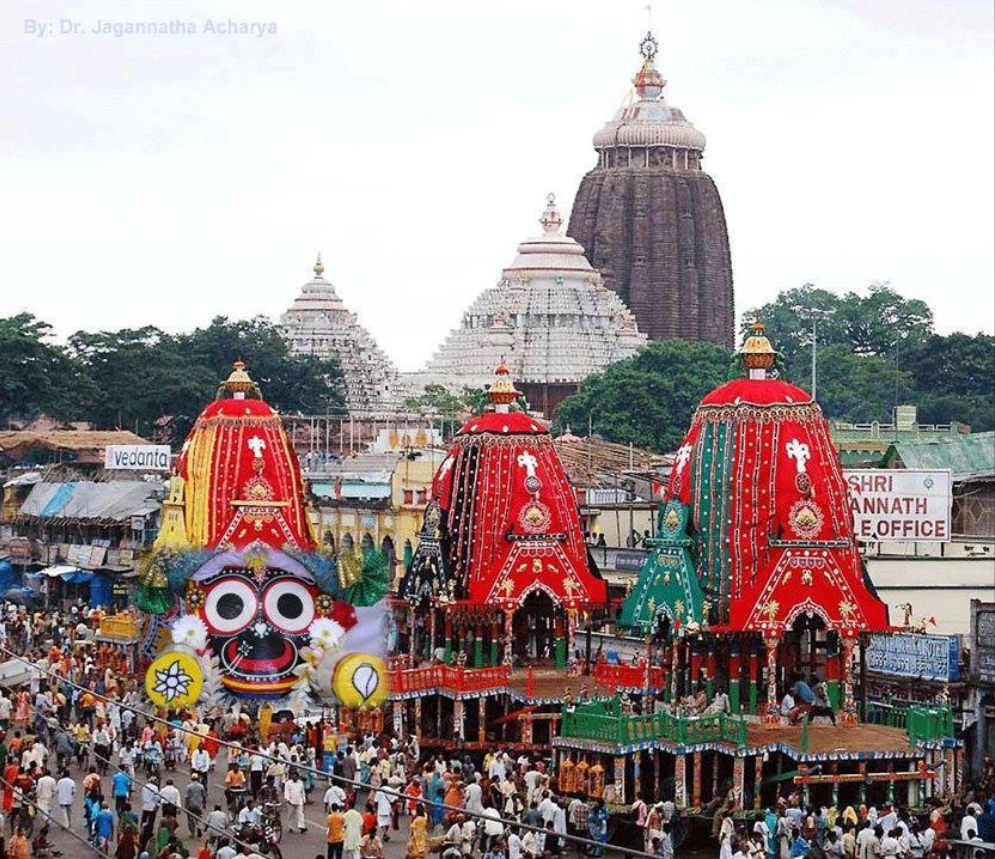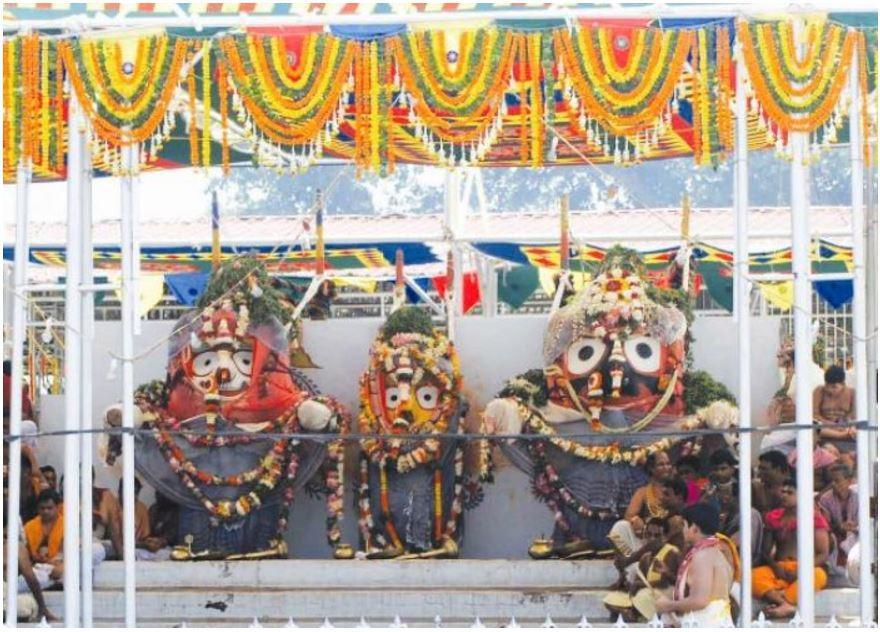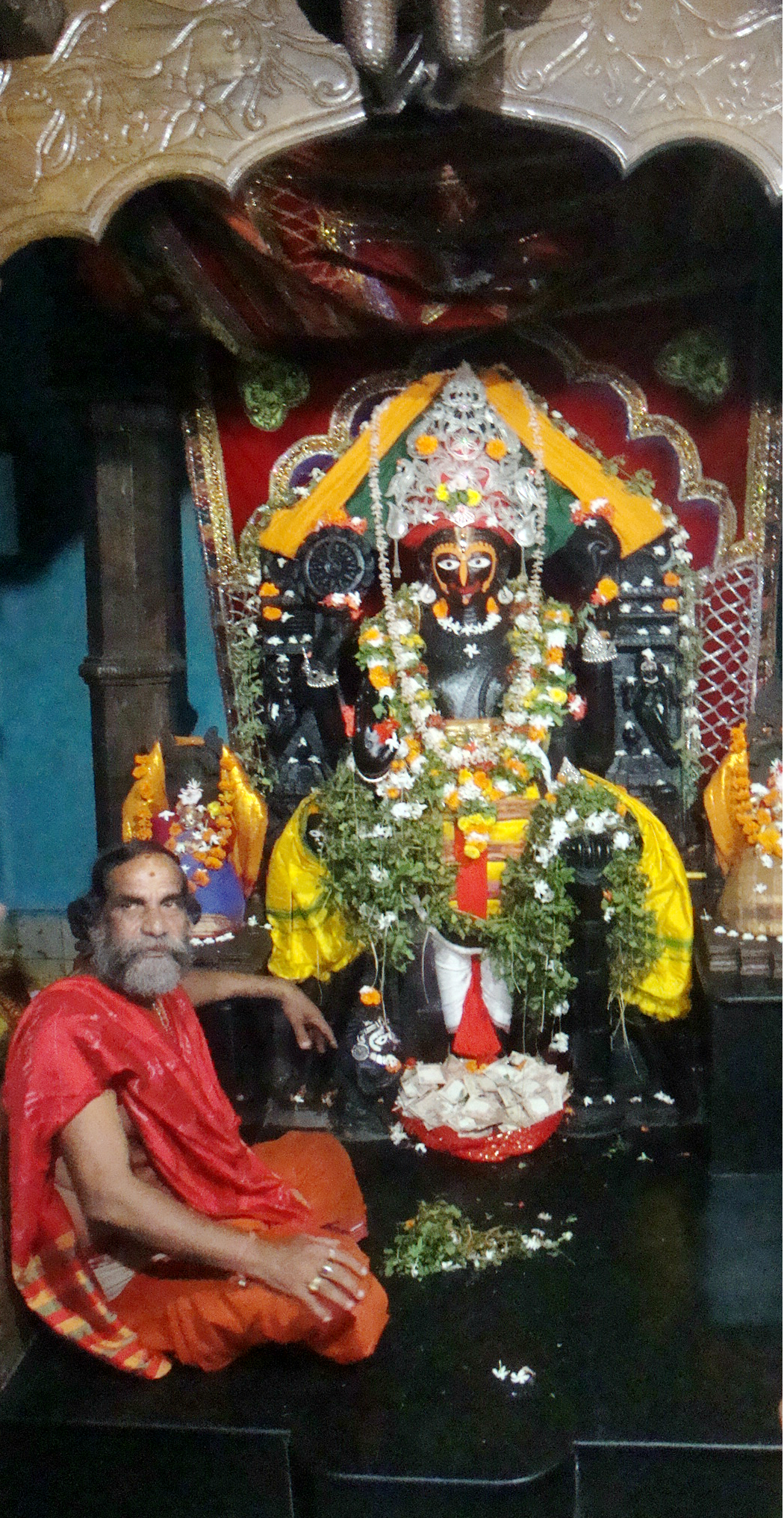By Asutosh Mohanty

Jagaṅnātha Mahāprabhu (the avatāra of Bhagwān Srī Viṣñu), Bhagwān Balabhadra and Dēvī Subhadrā are considered to be the forms of the omnipresent, omniscient and omnipotent supreme power, manifest as ‘Darubrahma’ (the Supreme Being manifesting itself in a block of wood). Srī Viṣñu’s weapon Sudarśana Ćakra as the fourth divine manifestation is also worshipped along with the divine trinity and together these four are known as the Ćaturddhamūrti or the four-fold divine images.
The Purī Maṇdira is not only associated with the Dēvas and Dēvīs presiding therein, but also contain within it an entire cultural heritage associated with Śrī Kśētra or Śrī Maṇdira and all other small maṇdiras within its precincts, which brings in the hearts of the bhaktas’ or pilgrims’ lasting joy and contentment.
Śrī Kśētra is built in the shape of Śaṅkha (a conch shell of ritual and religious importance in Hinduism). Śrī Kśētra is therefore also known as Śaṅkha Kśētra. Hence every part of the Jagaṅnātha Dharma carries a socio-cultural and spiritual significance to be deeply understood and appreciated.
Jagaṅnātha represents an integration of all important Hindu traditions that flourished in India, viz, the Vaidika, the Paurāñika, and Taṅtrika, Smārtha and the Vaiṣñava. Jagaṅnātha Mahāprabhu is worshipped as Nārāyaña or Viṣñu when he is on the Ratnavēdi (dias) in the sanctum sanctorum, as Gañēśa when on the ‘Sṅānavēdi’ during the Sṅāna Pūrñimā, as Rudra (an aspect of Śiva) during the ‘Nava-Kalēvara’ ceremony, as Durgā in the Śayana festival, and as the Sun when on the Ratha during the Ratha Yatra or ‘Car festival’.
Dēva Sṅāna Pūrñimā
“Sṅāna guṇdīća ae swam bēni līla jara
Patitapābana arthu prasādu bahara”

Dēva Sṅāna Pūrñimā is the auspicious bath ceremony of Jagaṅnātha Mahāprabhu which is celebrated on the pūrñimā i.e. full moon day of Hindu Calendar month Jyēṣṭha (lunar month falling in May-June) to memorialise the appearance of the Ćaturddhamūrti (Jagaṅnātha Mahāprabhu, Bhagwān Balabhadra, Dēvī Subhadrā and Sudarśana Ćakra).
As per Skaṇda Pūrāña, the legendary king Iṇdradyūmna arranged for the bathing ceremony of the Ćaturddhamūrti on the pūrñimā of Jyēṣṭha month and since then over the centuries it has been celebrated as Dēva Sṅāna Pūrñimā (Fig. 1). This auspicious festival is not limited to Śrī Maṇdira but celebrated in all Jagaṅnātha shrines all over India and the world.
On the previous day of Sṅāna Yātra (as it is also known) the vigraha (images) of Jagaṅnātha Mahāprabhu, Bhagwān Balabhadra, Dēvī Subhadrā and Sudarśana Ćakra are ceremonially brought out in a procession to the Sṅāna-vēdi (Sṅāna Maṇdapa) a designated platform for the bath ceremony situated near the northern gate of Śrī Maṇdira. The Sṅāna Maṇdapa has been ingeniously built so that bhaktas or devotees can easily obtain a view of the Ćaturddhamūrti even standing in Śrī Kśētra.
The Ćaturddhamūrti are bathed with water brought in 108 gold vessels (Jagannatha Mahaprabhu – 35, Bhagwan Balabhadra – 33, Devi Subhadra – 22 and Sudarsana Chakra – 18) filled at the Sunā Kuaṅ or the ‘Golden Well’ situated inside Śrī Maṇdira. This vidhi or ritual is known as jalābhiṣēka (jala meaning water, and abhiṣēka meaning ritual bathing with water). The filled vessels are carried in procession by suaras / daitapatis (special servants of Jagaṅnātha Mahāprabhu) walking in single file. This vidhi is called ‘jalādhivāsa’.

After jalābhiṣēka, Jagaṅnātha Mahāprabhu and Bhagwān Balabhadra are dressed in the like of Bhagwan Gañēśa with a headress shaped as elephant head, and Dēvī Subhadrā adorned with a mukuta or crown of lotus flowers. This form of Jagaṅnātha is known as ‘Gajānana vēśa’ (Fig. 2).
As per itihāsa (traditional narrations of history), it is believed that a renowned scholar in the past from present-day Maharashtra, Gañapati Bhaṭṭāra, who was also a devoted bhakta of Bhagwan Gañēśa, visited Puri centuries ago. Honouring his vast knowledge, the King of Kalinga at that time rewarded him for his scholarship and invited him to visit Śrī Kśētra and to worship Jagaṅnātha Mahāprabhu. The scholar refused to visit saying that he conceived of Bhagwān as Gañēśa alone could therefore not bring himself to worship any other form. The King however persuaded him to visit and brought him to the Sṅāna Maṇdapa. Jagaṅnātha Mahāprabhu is said to have appeared to Gañapati Bhaṭṭāra in the form of Gañēśa to give darśana (vision) to him in the bhāva (inclination) of the devotee. The tradition of dressing Jagaṅnātha Mahāprabhu in Gajānana vēśa or Hāthi vēśa after the jalābhiṣēka follows from this legend.
This costume is offered by Gopaltirtha Matha and Raghavdas Matha (monasteries).

After jalābhiṣēka, the Ćaturddhamūrti are kept away from the bhaktas for fifteen days in a place called ‘Ratna Vēdi’ (sickroom) inside the Śrī Maṇdira. The deities are said to have fallen sick and recuperating in a secluded room. This short period is also known as ‘anābasāra kāla’, and the Śrī Maṇdira remains closed in this period.
During ‘anābasāra kāla’ the bhaktas visit Alārnātha Thākura considered and avatāra of Śrī Kṛṣhña, at Brahmagiri in Puri district. The itihāsas narrate that Jagaṅnātha Mahāprabhu had advised his bhaktas that for this short period he will appear and give darśana to them in the form of Alavār Nātha (Fig. 3).
On the 16th day, the Chaturddhamurti are ready for the viewing of the devotees known as ‘Navayauvana Darśana’. The ritual of ‘nētrōtsava’ (repainting of the mūrtis which get washed off during the bath ritual) is also observed on this day, and the world famous chariot festival or ‘Ratha Yātrā’ commences the following day.
ନୀଳାଦ୍ରୌ ଶଙ୍ଖମଧ୍ୟେ ଶତଦଳକମଳେ ରତ୍ନସିଂହାସନସ୍ଥ˚ ।
ସର୍ବାଳଙ୍କାରଯୁକ୍ତ˚ ନବଘନରୁଚିର˚ ସଂଯୁତ˚ ଚାଗ୍ରଜେନ ।।
ଭଦ୍ରାୟା ବାମଭାଗେ ରଥଚରଣଯୁତଂ ବ୍ରହ୍ମ୍ରରୁଦ୍ର˚ଦ୍ର ବନ୍ଦ୍ୟ˚।
ବେଦାନା˚ ସାରମୀଶଂ ସ୍ଵଜନପରିବୃତ˚ ବ୍ରହ୍ମଦାରୁ˚ ଭଜେଽହମ୍ ।।
References/Sources:
- Utkal Prasanga (Monthly Odia Magazine published by Odisha Govt.
- Odia newspaper – Prameya
- http://jagannath.nic.in/?q=home
- orissa.gov.in
- http://rathjatra.nic.in/about.htm
- http://www.nabakalebara.gov.in/
- http://www.rathyatra.org/devasnana-purnima.html
- OTV News
- http://www.nabakalebara.gov.in/newsDetails/In-News/134
- Image credits
- http://jagannath.nic.in/?q=home
- OTV News
- Orissa Post
- http://incredibleorissa.com/

Author: After a successful stint with PT Education & Hewlett Packard Enterprise into Technology Consulting, Asutosh Mohanty has been working with Gaurav Pradhan Foundation (GPF) which is a non-profit organisation working towards strengthening the social and economic fabric of India.
Acknowledgement: This article would not have been possible without the significant inputs and generosity of my parents.
